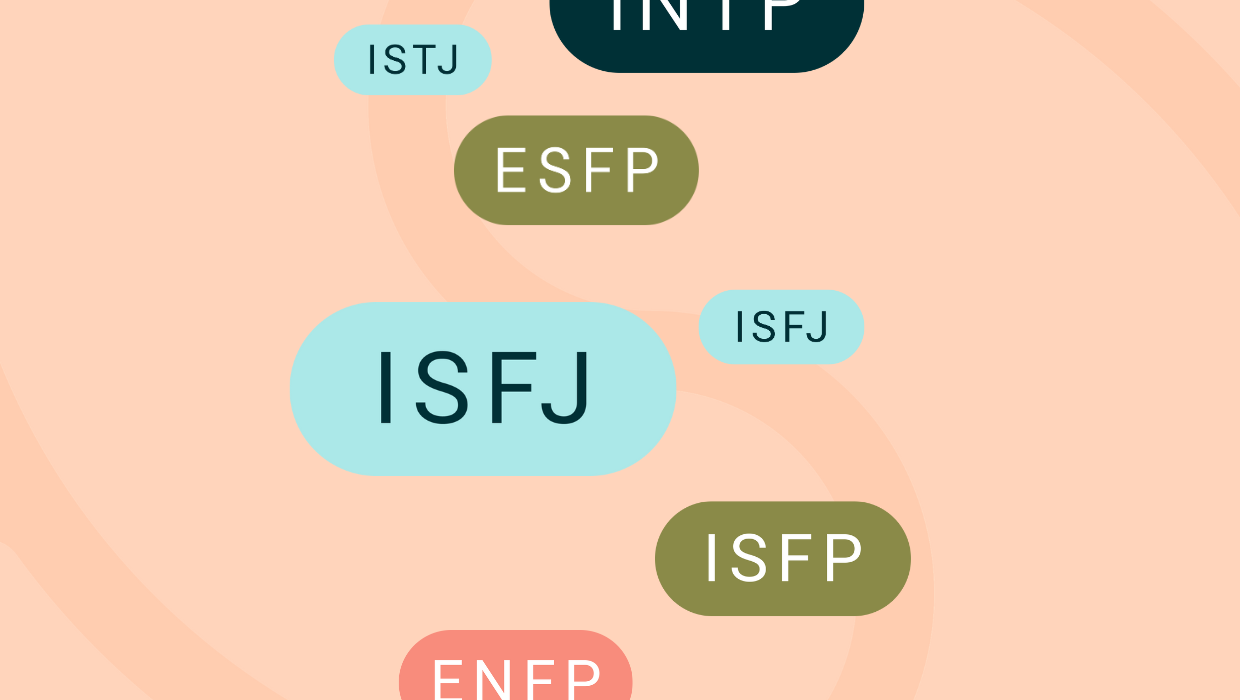The Most Common Personality Types Ranked
Today we rank the personality types from least to most common. We all have our own quirks and personality traits, but which is the most common personality type?

Today we rank the personality types from least to most common. We all have our own quirks and personality traits, but which is the most common personality type?
Personality types refer to the different attitudes, behaviors and traits that make each individual unique. There are 16 personality types, each identified by a four-letter code. Each type has its own set of characteristics that help to define individuals and their interactions with others. Understanding these different personality types is key to understanding human behavior and relationships.
The Myers-Briggs Foundation published data estimating the relative frequency of each of the sixteen types in the United States population. We’ve used this data to rank the personality types from the least to most common.
It’s important to remember that everyone is unique, and you should not compare your individuality with anyone else. We all have something exceptional and meaningful to contribute to the world – regardless of how common or uncommon our type is. There are 8 billion people worldwide, and 8 billion different personalities. The world would be a boring place if we were all the same.
So, here are the personality types ranked from least common to most common. If you don’t know your personality type, you can take our free 5-minute personality test.
Least to most common personality types

16. INFJ: 1.5%
1.5% of the population falls into the INFJ personality type designation, making it the least common personality type. INFJs are deep thinkers who take their time to form opinions and generally shy away from small talk. They have a great capacity for empathy, understanding others intuitively, and often taking up causes that benefit those in need.
There is a slightly higher percentage of female INFJs than male INFJs, with 1.60% and 1.20%, respectively. INFJ is the least commonly found personality type amongst men, with just 1.20% of males having it as their type.

15. ENTJ: 1.8%
ENTJs comprise 1.8% of the population, making them the second least common personality type. ENTJs are born leaders, possessing an assertive nature and an excellent capacity for getting things done. They communicate clearly and decisively, fearlessly taking charge of any situation they confront. Results-driven problem solvers with impressive poise and confidence, ENTJs know how to make their presence felt. ENTJs thrive in challenging work environments and are the people who lead initiatives in their professional lives.
Male ENTJs comprise approximately 2.70% of the population, whereas female ENTJs only represent 0.90%, making them the joint rarest personality type among women.

14. INTJ: 2.1%
INTJ is the third least common personality type at only 2.1% of the population. INTJs are logical, analytical thinkers who often view the world as a puzzle ready to be solved. They are independent thinkers driven by a passion for learning and understanding the world around them. With their acquired knowledge, INTJs devise strategies to achieve future goals.
Male INTJs make up 2.60% of the population, while female INTJs are even rarer at only 1.50%. What’s more, this personality type is joint-rarest among women – tied with ENTJ females for the least common.

13. ENFJ: 2.5%
ENFJs comprise 2.5% of the population, making them the fourth least common personality type. ENFJs exhibit a heightened sense of empathy, excellent interpersonal skills, and a deep understanding of human needs. Their ability to put other people’s feelings ahead of their own makes them invaluable in leadership positions or any management role.
Although the percentage of female ENFJs is substantially higher than male ENFJs, with 3.30% and 1.60%, respectively, they are both still considered rare personality types.

12. ENTP: 3.2%
ENTPs are the twelfth most common personality type, representing 3.2% of people in the US. ENTPs are quick-thinking innovators who bring a unique perspective to any situation they encounter. They’re great problem solvers and often thrive when they can creatively solve difficult problems.
ENTPs tend to be open-minded and always look for new ideas and possibilities. Although females represent only 2.40% of the population, male ENTPs make up 4.00% – nearly double.

11. INTP: 3.3%
INTPs comprise 3.3% of the population and are the eleventh most common personality type. INTPs are independent, creative thinkers who prefer to work on projects alone. They are inquisitive and have a deep thirst for knowledge. INTPs are not only analytical and introspective, but they also have a tendency to detach from reality and get absorbed in their inner world. They often appear distant as they like to observe situations before engaging with them.
The population comprises 1.7% INTP female and 4.8% INTP male individuals. This makes female INTPs profoundly scarcer than male INTPs.

10. ESTP: 4.3%
ESTPs make up 4.3% of the population, making them the tenth most common personality type. This position also means ESTPs are the rarest of the Sensor personality types. ESTPs are daring and independent individuals who are always looking for new challenges. They often enjoy highly physical activities, like sports or adventure activities, as they take pleasure in testing their limits. With the ability to quickly and effectively resolve issues, they possess a no-nonsense approach that yields excellent results when faced with any circumstance.
The percentage of male ESTPs is significantly higher than female ESTPs, at 5.60% and 4.00%, respectively.

9. INFP: 4.4%
Representing 4.4% of the population, INFPs are the ninth most common personality type around. INFPs are driven by a strong sense of values and strive to live in accordance with their beliefs. They’re open-minded individuals who are often creative and imaginative, with a talent for expressing their ideas through words. INFPs have strong intuition and are incredibly sensitive to their surroundings. They prefer working in an environment that allows them the freedom to explore and create.
The percentage of female INFPs is just ever-so-slightly higher than that of male INFPs, with 4.60% and 4.10%, respectively.

8. ISTP: 5.4%
The eighth most common personality type is ISTP, making up 5.4% of the population. ISTPs thrive when presented with new challenges and often approach problem-solving with a practical, hands-on mentality. They are incredibly independent individuals who prefer to do things on their own terms. ISTPs are often pragmatic and logical – relying on facts rather than feelings or emotions.
Of the 5.4% of ISTPs, 8.50% are male, while only 2.30% are female – a significantly higher proportion of males than females for this personality type. This, in fact, makes ISTP the least common personality type among female Sensors.

7. ENFP: 8.1%
ENFPs make up 8.1% of the population, making them the seventh most common personality type. This seventh position makes ENFPs the most common of the iNtuitive personality types. ENFPs are sociable individuals who often bring energy and enthusiasm to any environment. They are driven by a strong desire for connection and understanding and make great communicators. ENFPs are passionate people who seek out meaning and purpose in life.
Out of the 8.1% population of ENFPs, there is a higher percentage of females compared to males, with 9.70% and 6.40%, respectively.

6. ESFP: 8.5%
Ranking sixth on the list are ESFPs, making up 8.5% of the population. ESFPs are fun-loving, outgoing people who enjoy being the center of attention. They are highly social and always up for an adventure. ESFPs are incredibly curious and thrive when surrounded by new experiences and stimulation. With a strong sense of practicality, they often prefer to get tasks done immediately and efficiently.
Female ESFPs comprise of 10.10% of the female population, while male ESFPs comprise of 6.90% of the male population.

5. ESTJ: 8.7%
Representing 8.7% of the population, ESTJs are the fifth most common personality type. ESTJs are determined, organized individuals who are often the backbone of many organizations. They have an excellent memory and a knack for facts and details, making them great leaders in any group. ESTJs are driven by a strong need for order and security, always striving to ensure everything runs smoothly according to their standards.
A significantly higher percentage of male individuals present as ESTJ than female individuals, with 11.2% and 6.3%, respectively. This makes ESTJs the second most common personality type for males.

4. ISFP: 8.8%
ISFPs comprise 8.8% of the population and are the fourth most common personality type. ISFPs are incredibly gentle and sensitive individuals who prioritize their own values above all else. They are often creative and free-spirited individuals with a strong sense of empathy for others. ISFPs prefer to take the path less travelled, exploring new ideas and seeking out adventure.
Female ISFPs make up 9.90% of the female population, while male ISFPs comprise 7.60% of the male population.

3. ISTJ: 11.6%
ISTJ is the third most common personality type, comprising 11.6% of the population. ISTJs are reliable and dependable people who take their obligations seriously. They are incredibly practical and logical, always striving to make sense of everything around them. ISTJs value order and structure and thrive when things follow a clear set of rules.
The percentage of male ISTJs is markedly higher than female ISTJs, with 16.40% and 6.90%, respectively. This makes the ISTJ personality type the most popular among males.

2. ESFJ
The ESFJ personality type is the second most common of all, with 12.0% of people exhibiting this type. ESFJs are incredibly warm and kind-hearted individuals who value social harmony above all else. They always strive to be of service to others and prioritize relationships over any personal ambition or goal. ESFJs are loyal, caring people who go out of their way for those they love.
The ESFJ personality type is significantly more common among women than men, with 16.90% of the female population being ESFJ compared to 7.50% of the male population. This makes ESFJ the second most common type for females.

1. ISFJ
ISFJ is the most common personality type, representing 13.8% of people in the US. ISFJs are gentle, warm-hearted people who are highly responsible and organized. They strive to maintain long-term relationships with those close to them and often go out of their way for the sake of others. ISFJs are thoughtful, caring people with a strong sense of duty and responsibility.
ISFJs are the most common female personality type, representing 19.40% of all women. While 8.10% of men in the population are ISFJs.
What is the most common personality type?
ISFJ is the most common personality type representing 13.8% of the population. this is predominantly dominated by females, with 19.4% of women being ISFJs compared to 8.1% of men. ESFJ is the second most common type for all genders combine and for women.
The most common type among men is ISTJ, representing 16.4% of the male population. While the second most common type for males is ESTJ, making up 11.2% of male individuals.
The top four most common types are ISFJ, ESFJ, ISTJ and ISFP. Regardless of gender, these four personalities make up nearly half of the population in the United States. All o these personality types are Sensors.
There is a clear weighting towards Sensor types among the most common personality types.
This can be seen in the fact that all eight of the Sensor personality types make up 73% compared to all iNtuitive types comprising 27% of the population. This indicates that Sensing is the more dominant personality trait among the population.
It should be noted that we are all unique, and we should not compare our personality types to anyone else’s. Each individual has something special and valuable to share the world, no matter how common or uncommon their personality type may be.
Regardless of your personality type, embrace your strengths and celebrate your individuality. The diversity of the personalities around us is what makes this world so interesting and vibrant.
Now that you know the most common personality types, it’s time to find out which personality types are best in bed.




